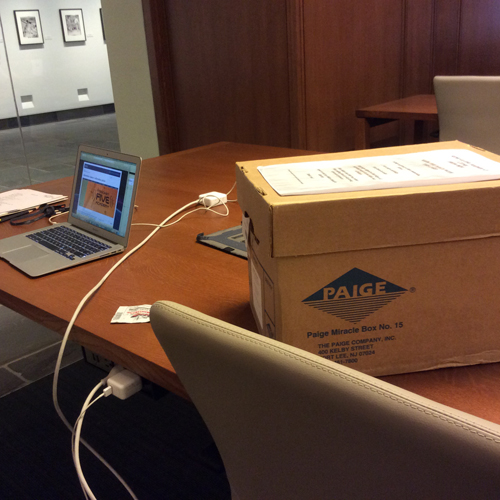Following the Triangle Scholarly Communication Institute held at the Rizzo Center, I journeyed to Duke University’s David M. Rubenstein Rare Book & Manuscript Library where The Judy Malloy, Stephanie Strickland, and Rob Kendall Papers are held. For a day and a half I rummaged through 12 boxes of notebooks, photos, art artifacts, and ephemera relating to Malloy’s Uncle Roger, Strickland’s True North, and Kendall’s “Faith.” Here in these gorgeous surroundings with access to a free high res scanner, ample librarians to provide support, and archives with so many treasures from our electronic literary history, I was struck with the idea that doing this research in this way on this topic represents the marriage between the traditional Humanities where archival research into literary artifacts is a key research methodology and Digital Humanities that values born digital output, including literary art. And I thank the gods for the education I had at UTDallas’ unique interdisciplinary Humanities masters and PhD programs that allowed me to study Homer and hypertext at the same time. I do not think my professors had any idea what they were giving birth to when they allowed me to put my research into Homer’s Penelope online in 1993 or defend my dissertation about Penelope in a MOO. But this is a topic for an essay, so I’ll get back to my experience the Rubenstein Library . . .
Needless to say, I found information that requires me to make some changes and additions to the Malloy section of Pathfinders eBook and the chapter on Uncle Roger in the Traversals manuscript (Re: the original cost of Version 3 sold through Art Com; the content for the missing Record #62 of A Party in Woodside; the real last name of Jenny, the narrator; evidence of reoccurring tropes in Malloy’s work).
In all I took over 50 scans, 100 images, and a notebook full of notes. I am organizing them today in a folder so that I can add them to my own research archives.
Screenshot of Diana Slattery’s Glide Project
A topic of conversation I had with one of the librarians was about the notion of a secondary archive housed within the primary archive. What I mean by this is that inside the Stephanie Strickland Papers was a CD containing Diana Slattery’s Glide Project, one of the most complex and gorgeous works of net art from the late 1990s and early 2000s. I had done quite a bit of research into this work in the early 2000s including a video-hypertext interview published by The Iowa Review Web in 2004. I came across the reference to Glide under the heading “Writings by Others” when scouring the online Guide to the Strickland Papers. I was delighted to see it––I had looked high and low for this work online for the past five years only to learn that it had been removed from RPI’s server some years ago. It has remerged as the Glide Oracle app on the iTunes Store in 2012, but this version represents but one module of the many that the original work contained. Created with Macromedia Shockwave, Glide was headed for obsolesce anyway, I guess, but with only a handful of screen shots of the work, I was very sad that it was no longer available even for ELL’s vintage computers, which could indeed still access the work. The Rubenstein (what joy!) has a CD that Slattery gave to Strickland that the librarians in their infinite wisdom (thank goodness!) copied over to a server and onto a PC laptop––that is all that is left of this work. Also part of this secondary archive are Deena Larsen’s thesis, papers by Marjorie Luesebrink, Joe Tabbi’s Cognition Fictions, to name but a few other items. Treasures like this also can be found in the Malloy Papers. The question it raises is, “How best to present this additional trove of information better so that scholars know it is available?” I see that I have some work to do in the ELMCIP Knowledge Base for starters.
As you can see, this brief journey to the Rubenstein has sparked some ideas about archiving and presenting works of electronic literature. I am not even going to talk about some of the major issues that have been rolling around in my brain since I began working on Pathfinders. I’ll save that for my next book . . .
I want to go on record thanking the Rubenstein Library’s Sara Seten Berghausen, Andrew Armacost, and Naomi Nelson for their support for my research and Duke University for creating such a wonderful resource for scholars working in electronic literature.





